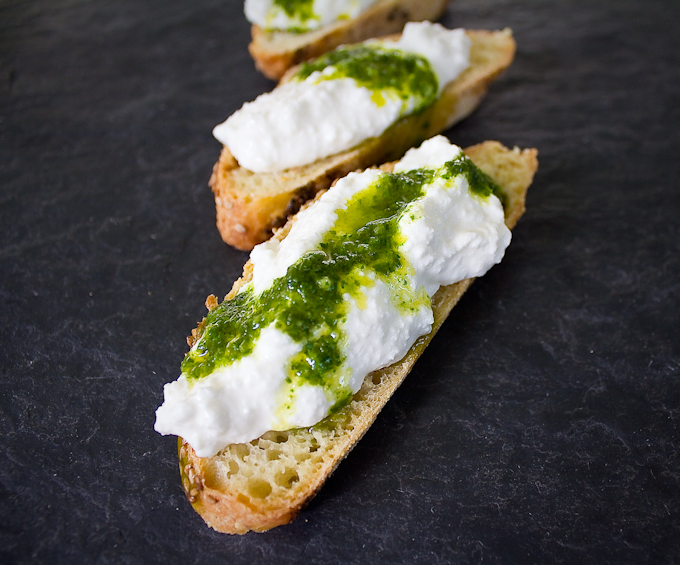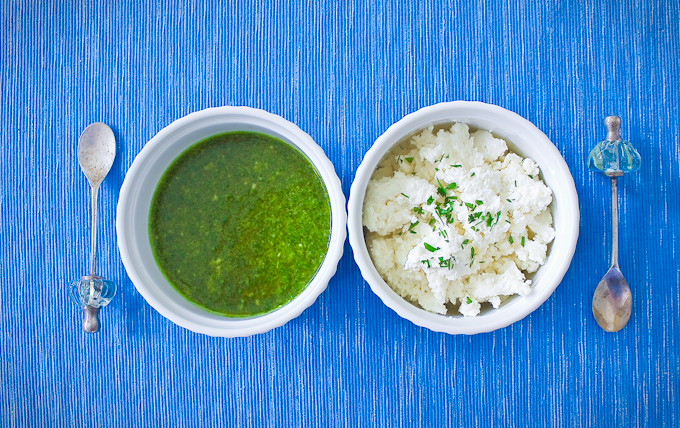My son just celebrated his very first birthday. I was naturally flooded with an enormous range of huge emotions. But, instead of being very weepy and nostalgic for the entire month prior, staring at him constantly, willing time to stop, I instead funneled all of my sentimentalism into obsessing about his very first birthday cake. This process was not unlike trying to make each precious decision about our wedding. Would this be the best choice, that I will then look back on in a decade and remember with zero regrets and nothing but fondness? Or even more, is this the best choice of all of the options I have entertained in my mind imagining this day for the last 3+ decades? Of course, an impossible assignment. But wanting it to be a perfect day and first cake experience for him, I pored over old family recipes scribbled in pencil on cocoa-powdered index cards. My first thought was my dad's carrot cake recipe. It is spectacular. But I kept looking, and came across again Aunt Margaret's Chocolate Frosting. It is the perfect, dark, rich, everything your yellow birthday cake screams for recipe. It is one of the top three recipes in our family's repertoire. Certainly worthy of a first birthday party. I then pictured him smashing his first piece of his first birthday cake into his face with his chubby hands, and pictured dark brown Jackson Pollock's covering the walls of my grandparents' condo. (I also then remembered a first birthday I attended where the cake was red velvet, leaving the kid and high chair looking like something out of a slasher film.) So opting for a more neutral hued confection, I finally settled on the dense-banana-cream cheese-miracle that is Amy's Bread's Monkey Cake Ok, so what's the point? The point is that he's one, and loved the cake, and mostly likely would have loved any cake. I loved obsessing over what to make, baking it for him, whipping the frosting, and seeing him literally lick the plate. I also loved that it was an opportunity to really go back to my cookbooks, my notes and my recipe cards and rediscover old favorites. And work on something that I was excited to share with the people I love. That, after all, is exactly why I cook.
 | ||||||||||||||||||||||
With our growing season a little later here in slightly cooler upstate New York, we still have bundles and bundles of garlic scapes in the markets and gardens for a week or two. A garlic scape is the flower shoot that has shot up from the stem of a hardneck garlic bulb when growing. The scapes are slender, bright green, and often twisting and turning in elegant swan-like shapes. Shortly after they appear, which seems to happen almost overnight, it is important to snap them off of the rest of the stem to allow the garlic plant to instead put its energy into growing the garlic bulb, which will be harvested a few weeks later. The scapes have a flavor that is definitely garlic, but much mellower, with hints of herbal summerness. They make a stunning pesto, turning into an outrageously bright green paste that keeps its color when cooked or frozen. I will often just puree garlic scapes with olive oil and freeze in about one cup portions that will keep for several months. Always on the lookout for new oils and vinegars for homemade salad dressings, this year I made garlic scape infused vinegar. It will still be a week or so before it hits its full potency, but so far so good, and the snaking scapes in the bottles are stunning if nothing else. The vinegar will be beautiful in simple vinaigrettes to dress greens and cucumbers from the garden, and also added to a marinade for grilling meat and seafood, splashed on sauteed chard, collards or kale, or for dunking crusty grilled bread. If your herb garden is overflowing, you can certainly add a few sprigs of basil, dill, thyme, or even a dried chili pepper to the bottle for your own personal melange. Experiment, use what is around you, and enjoy. GARLIC SCAPE VINEGAR 1-2 whole garlic scapes, about 12" in length 1 cup light flavored vinegar, such as white wine vinegar or rice vinegar Glass container non-metal cap or cover Note: I like the ratio of 1-2 scapes per cup of vinegar, but you can certainly add more to make the flavor more concentrated. And absolutely double or triple the recipe based on the size of container you are using. Triple the recipe, for example, if using a wine bottle. 1. Sterilize the bottle and cap, either by simmering in hot water on the stove for 10 minutes or washing in the dishwasher right before using. Allow to container and cap to dry thoroughly. 2. Wash garlic scapes and dry completely. Cut into lengths that will allow the scape to be completely submerged below the level of the vinegar. Any exposed piece of scape not in the vinegar will start to deteriorate and rot. 3. Gently bruise the scapes, by rolling over slightly with a rolling pin, to release a bit more flavor. 4. Place the scape pieces in the sterilized container and cover completely with vinegar. Cover with lid, cap or cork. 5. Store in the refrigerator, or other cool, dark place. The following day, check the level of the vinegar and add more if the level has dropped at all. It is possible that the scapes will absorb some overnight. 6. Allow to infuse for 10 days to 2 weeks, in a cool, dark place. Strain out original garlic scape pieces, if desired, and replace with fresh ones (if available), primarily for decoration. Will keep for 2-4 months. Keep vinegar bottle out of sunlight or it will become cloudy. The acid in the vinegar acts as an inhibitor for bacteria growth, but certainly keep an eye out for changes in color, an off smell, or cloudiness in the bottle and discard if there is a question. Storing the vinegar in the refrigerator, particularly in the summer months, is the safest. 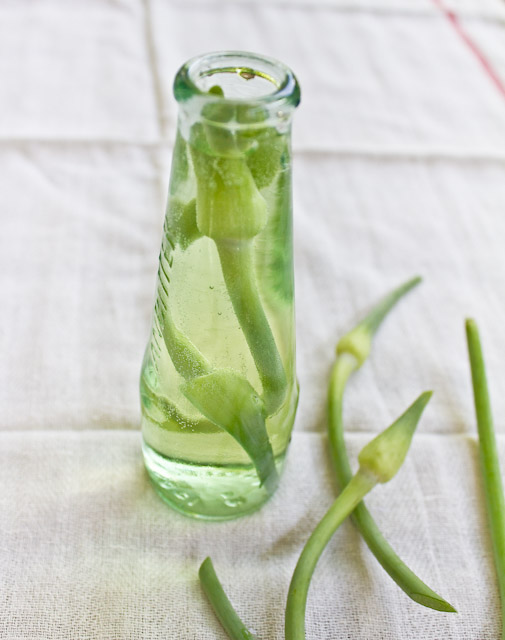 | ||||||||||||||||
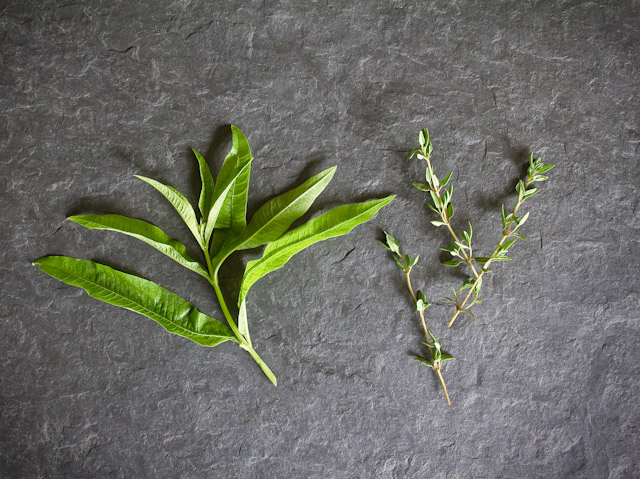 Our herb garden is growing like weeds. Well, truth be told, the weeds are also growing like weeds. But between the weeds are fragrant, mystical herbs, that are spicing up meals and will also shortly be hoarded away in ziplocks in the freezer for less bountiful months. My favorite herb is lemon verbena. It smells like something that should come from a much more tropical locale--even the plant, with its woody stems and slender leaves, looks rainforesty. Rubbing your fingers on one of the leaves, as I do at the start of many days, is an instant antidepressant. Bright, intensely fragrant, with an aroma and flavor that is distinctly the sweeter side of citrus. Too much and it can make a dish taste like bad perfume, in the right amounts it is transporting. My husband's favorite herb is thyme. It definitely stems (pun intended) from his early childhood-rooted love affair with weekly roast chickens. He painstakingly freezes bunch upon bunch of this savory treasure and stuffs several sprigs under the skin of our weekly roast chickens through the year--as well as it being used in our homemade soups and beloved stocks. So this recipe is a love letter to our favorite herbs. Citrus and thyme marry beautifully, fortunately for us, and both herbs are in great abundance now and for the next couple of months in gardens and markets. A not-too-sweet aromatic addition to sodas and cocktails, and a refreshing palate cleanser when spun into a sorbet or scraped into a granita. Try any of the above with a few fresh berries, oh my. (more…) | ||||||||||||||||
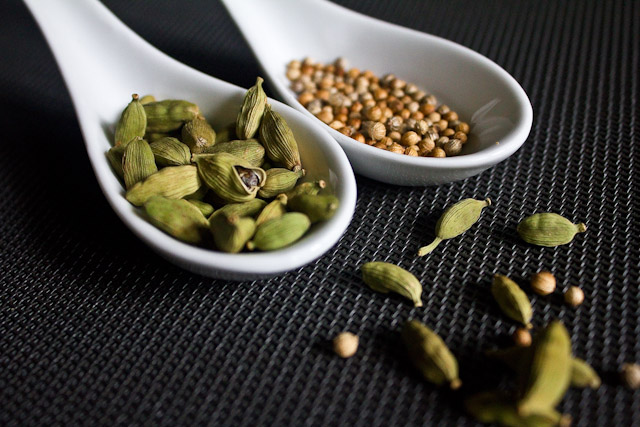 The cilantro we planted in our garden around Memorial Day, has already started to bolt some from the heat in recent weeks--it is nearly July after all--and shortly will start to go to seed. Those seeds, as you may or may not know, are coriander. They will first be plump and bright green, a wonderful ingredient in and of themselves, then maturing and drying to the tan spice with which we are more familiar. They'll probably be showing up at the farmer's markets shortly too. Cardamom comes from a tropical plant, so probably won't be making any appearances at my New York State farmer's markets or gardens, but is a flavor that seems to scream summer and snuggle up exceptionally well with summer flavors. Peaches, apricots, lemons, pears, warm weather baked goods, and definitely coriander, all have a great affinity for pairing with cardamom. This soda syrup is a vacation in a glass on a steamy summer day. Mix it with seltzer (from my favorite appliance ever, the Sodastream Seltzer Maker Sip. Sip. Fizz. Fizz. CARDAMOM AND CORIANDER SODA SYRUP by Catie Schwalb Makes about 2 cups. 4 tablespoons whole green cardamom pods, crushed gently to expose inner black seeds 1 tablespoon whole coriander seeds 3/4 cup sugar 1 1/2 cup water Place coriander seeds in a small pan on medium-high heat. Toast gently, swirling frequently, until the seeds just start to become fragrant. Immediately remove from heat and pan. In a sauce pan combine sugar, water, coriander and cardamom. Bring to a boil, and then turn down to a moderate simmer for about three minutes, until all of the sugar has dissolved and the liquid is clear. Allow the syrup to sit and infuse with the flavors for at least and hour and up to overnight. Refrigerate if leaving for longer than a couple of hours. Strain syrup and discard spice solids. Store syrup in an airtight container in the refrigerator for up to five days. To make cardamom and coriander soda--Combine about 1 oz of syrup to 12 oz of seltzer, fill the rest of the glass with ice. Stir well. Adjust syrup, if you prefer a stronger flavor. Garnish with a slice of lemon. | ||||||||||||||||
With sorrel in its tangy, bright abundance at the farmers' markets now and throughout the summer, this pistou (or pesto or coulis) is a dynamite way to show it off. Set out a platter of baguette slices, ricotta, and the green stuff and let your BBQ guests at it for a DIY appetizer. Less work for you, no soggy for them. Or, as we did last night, set out a platter of it between you and your loved one on the porch and call it dinner. The lemony-green-herbal potency of the pistou is heavenly with the savory-creaminess of the homemade fresh ricotta. But it is also an incredible addition in any place where you want a little herby, slightly sour, punch. Toss it with warm pieces of boiled red potatoes for a new twist on potato salad, stir a small spoonful into a creamy root vegetable soup just before serving, toss with shrimp and orzo for a cold pasta salad, or drizzle over grilled vegetables, seafood, and chicken. This is also a wonderful recipe to use to put away sorrel for the winter. Make a big batch of the pistou and freeze in smaller portions, to stir into heavier winter dishes in the months to come. SORREL PISTOU AND FRESH RICOTTA CROSTINI by Catie Schwalb makes about 1 1/2 cups of sorrel pistou For the Pistou: 3/4 cup, packed, fresh sorrel leaves, thicker stems removed, washed and dried thoroughly 1/4 cup, packed, fresh parsley, washed and dried thoroughly 1 garlic clove 1 cup extra virgin olive oil about 4 turns of fresh black pepper salt to taste, a large pinch at least For the Crostini: Fresh ricotta cheese thin slices of baguette, toasted or grilled if desired For the pistou: Combine sorrel, parsley, garlic clove, olive oil, salt and pepper in a blender or food processor. Blend until uniform and smooth. Taste and adjust salt and pepper to liking. Will keep in an airtight container in the refrigerator for up to a week, but is most green and most flavorful the day it is made. It can also be frozen, and thawed overnight in the refrigerator. Stir before serving. For the crostini: Top slices of baguette, or thinly sliced rustic bread, with a large dollop of ricotta. Top with a generous drizzle of pistou. Serve immediately. Alternative: HERB POTATO SALAD Steam or boil red skinned new potatoes. Cut into bite-sized pieces while still warm, but cool enough to touch. Toss with a generous amount of sorrel coulis. Chill before serving. | ||||||||||||||||
|
|
{ welcome! }
 Catie Baumer Schwalb is a chef, food writer and photographer, who splits her life between the city and the country. Not too long ago Catie was a New York City based actress and playwright for more than a decade. She has her Master of Fine Arts from the National Theater Conservatory, and her Grand Diplôme in classic culinary arts from the French Culinary Institute in New York City.
... Read More ≫
Catie Baumer Schwalb is a chef, food writer and photographer, who splits her life between the city and the country. Not too long ago Catie was a New York City based actress and playwright for more than a decade. She has her Master of Fine Arts from the National Theater Conservatory, and her Grand Diplôme in classic culinary arts from the French Culinary Institute in New York City.
... Read More ≫{ get in touch }
{ what's new }
September 12, 2015
August 19, 2013
August 15, 2013
August 13, 2013
August 1, 2013
{ favorites }
{ archives }
Appetizers / Breads & Pastry / Breakfast / Cakes / Canning / Condiments / Dinner / DIY foods / Drinks / Fall / favorites / Grains / Holidays / Local / Noodles & Pasta / Pies & Tarts / Poultry / Salads / Seafood / Snacks / Soup / Spring / Summer / Sweets / Techniques / Vegetables / Vegetarian / Winter /
{ currently reading }
|





